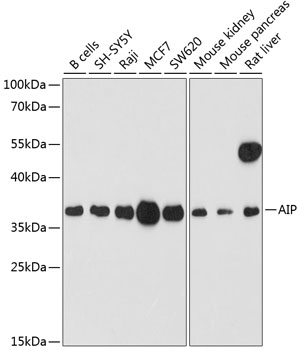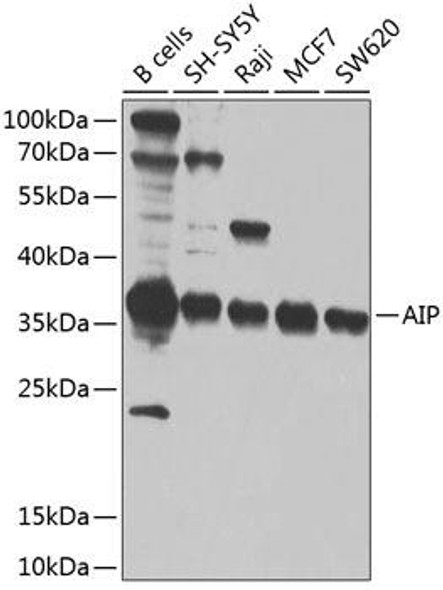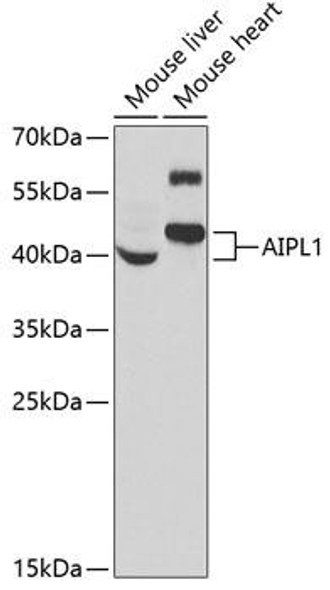Cell Biology Antibodies 3
Anti-AIP Antibody (CAB12546)
- SKU:
- CAB12546
- Product Type:
- Antibody
- Reactivity:
- Human
- Reactivity:
- Mouse
- Reactivity:
- Rat
- Host Species:
- Rabbit
- Isotype:
- IgG
- Antibody Type:
- Polyclonal Antibody
- Research Area:
- Cell Biology
Description
| Antibody Name: | Anti-AIP Antibody |
| Antibody SKU: | CAB12546 |
| Antibody Size: | 20uL, 50uL, 100uL |
| Application: | WB |
| Reactivity: | Human, Mouse, Rat |
| Host Species: | Rabbit |
| Immunogen: | Recombinant fusion protein containing a sequence corresponding to amino acids 1-330 of human AIP (NP_003968.3). |
| Application: | WB |
| Recommended Dilution: | WB 1:500 - 1:2000 |
| Reactivity: | Human, Mouse, Rat |
| Positive Samples: | B cells, SH-SY5Y, Raji, MCF7, SW620, Mouse kidney, Mouse pancreas, Rat liver |
| Immunogen: | Recombinant fusion protein containing a sequence corresponding to amino acids 1-330 of human AIP (NP_003968.3). |
| Purification Method: | Affinity purification |
| Storage Buffer: | Store at -20'C. Avoid freeze / thaw cycles. Buffer: PBS with 0.02% sodium azide, 50% glycerol, pH7.3. |
| Isotype: | IgG |
| Sequence: | MADI IARL REDG IQKR VIQE GRGE LPDF QDGT KATF HYRT LHSD DEGT VLDD SRAR GKPM ELII GKKF KLPV WETI VCTM REGE IAQF LCDI KHVV LYPL VAKS LRNI AVGK DPLE GQRH CCGV AQMR EHSS LGHA DLDA LQQN PQPL IFHM EMLK VESP GTYQ QDPW AMTD EEKA KAVP LIHQ EGNR LYRE GHVK EAAA KYYD AIAC LKNL QMKE QPGS PEWI QLDQ QITP LLLN YCQC KLVV EEYY EVLD HCSS ILNK YDDN VKAY FKRG KAHA AVWN AQEA QADF AKVL ELDP ALAP VVSR ELRA LEAR IRQK DEED KARF RGIF SH |
| Gene ID: | 9049 |
| Uniprot: | O00170 |
| Cellular Location: | Cytoplasm |
| Calculated MW: | 37kDa |
| Observed MW: | 37kDa |
| Synonyms: | AIP, ARA9, FKBP16, FKBP37, SMTPHN, XAP-2, XAP2 |
| Background: | The protein encoded by this gene is a receptor for aryl hydrocarbons and a ligand-activated transcription factor. The encoded protein is found in the cytoplasm as part of a multiprotein complex, but upon binding of ligand is transported to the nucleus. This protein can regulate the expression of many xenobiotic metabolizing enzymes. Also, the encoded protein can bind specifically to and inhibit the activity of hepatitis B virus. Three transcript variants encoding different isoforms have been found for this gene. |
| UniProt Protein Function: | Function: May play a positive role in AHR-mediated (aromatic hydrocarbon receptor) signaling, possibly by influencing its receptivity for ligand and/or its nuclear targeting.Cellular negative regulator of the hepatitis B virus (HBV) X protein. |
| UniProt Protein Details: | Subunit structure: Interacts with RET in the pituitary gland; this interaction prevents the formation of the AIP-survivin complex. Ref.9 Subcellular location: Cytoplasm. Tissue specificity: Widely expressed. Higher levels seen in the heart, placenta and skeletal muscle. Not expressed in the liver. Involvement in Disease: Growth hormone-secreting pituitary adenoma (GHSPA) [MIM:102200]: Pituitary adenomas include somatotropinoma and prolactinoma.Note: The disease is caused by mutations affecting the gene represented in this entry. Ref.4 Ref.8 Ref.10 Ref.11ACTH-secreting pituitary adenoma (ASPA) [MIM:219090]: A pituitary adenoma resulting in excessive production of adrenocorticotropic hormone. This leads to hypersecretion of cortisol by the adrenal glands and ACTH-dependent Cushing syndrome. Clinical manifestations of Cushing syndrome include facial and truncal obesity, abdominal striae, muscular weakness, osteoporosis, arterial hypertension, diabetes.Note: The disease is caused by mutations affecting the gene represented in this entry.Prolactin-secreting pituitary adenoma (PSPA) [MIM:600634]: Most common type of hormonally active pituitary adenoma.Note: The disease is caused by mutations affecting the gene represented in this entry. Sequence similarities: Contains 1 PPIase FKBP-type domain.Contains 2 TPR repeats. |
| NCBI Summary: | The protein encoded by this gene is a receptor for aryl hydrocarbons and a ligand-activated transcription factor. The encoded protein is found in the cytoplasm as part of a multiprotein complex, but upon binding of ligand is transported to the nucleus. This protein can regulate the expression of many xenobiotic metabolizing enzymes. Also, the encoded protein can bind specifically to and inhibit the activity of hepatitis B virus. [provided by RefSeq, Sep 2008] |
| UniProt Code: | O00170 |
| NCBI GenInfo Identifier: | 254763247 |
| NCBI Gene ID: | 9049 |
| NCBI Accession: | O00170.2 |
| UniProt Secondary Accession: | O00170,Q2M3Q2, Q99606, A0SZW3, A0SZW4, A0SZW5, A0SZW6 |
| UniProt Related Accession: | O00170 |
| Molecular Weight: | 37,636 Da |
| NCBI Full Name: | AH receptor-interacting protein |
| NCBI Synonym Full Names: | aryl hydrocarbon receptor interacting protein |
| NCBI Official Symbol: | AIP |
| NCBI Official Synonym Symbols: | ARA9; XAP2; XAP-2; FKBP16; FKBP37; SMTPHN |
| NCBI Protein Information: | AH receptor-interacting protein; immunophilin homolog ARA9; HBV X-associated protein 2 |
| UniProt Protein Name: | AH receptor-interacting protein |
| UniProt Synonym Protein Names: | Aryl-hydrocarbon receptor-interacting protein; HBV X-associated protein 2; XAP-2; Immunophilin homolog ARA9 |
| Protein Family: | AH receptor-interacting protein |
| UniProt Gene Name: | AIP |
| UniProt Entry Name: | AIP_HUMAN |




![Anti-AIP Antibody (CAB19969)[KO Validated] Anti-AIP Antibody (CAB19969)[KO Validated]](https://cdn11.bigcommerce.com/s-rd6ounxcu2/images/stencil/590x590/products/56136/61318/anti-aip-antibody-cab19969ko-validated__25895__60238.1706533768.jpg?c=1)


